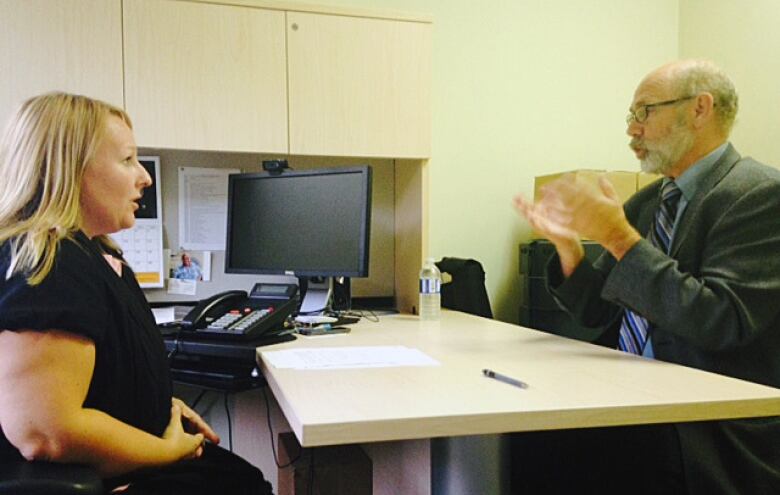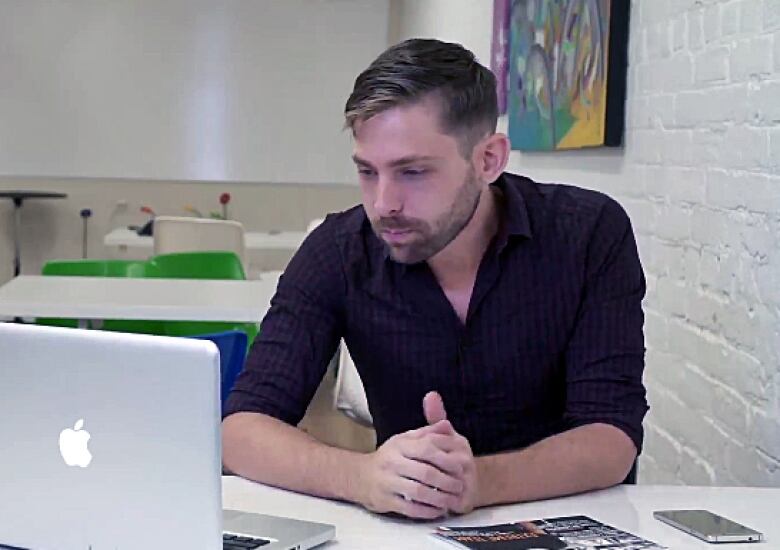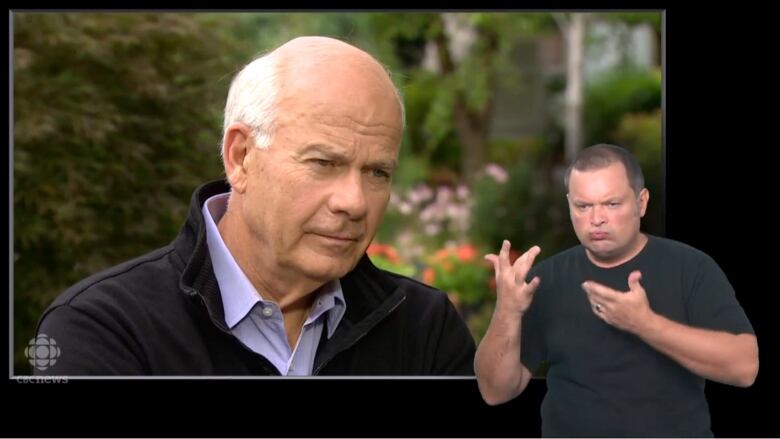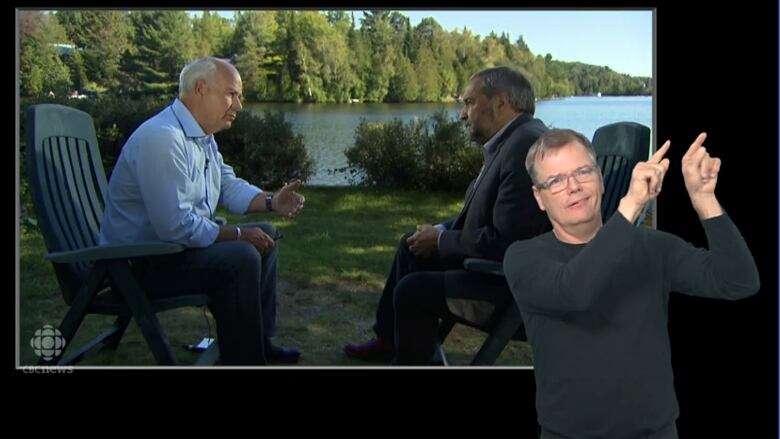Why CBC used sign language to interpret federal leader interviews
It may be an election first, but is ASL better than closed captioning?
A television program that CBC News will broadcast on Saturday may create some election buzz and debate in one community.
In what is said to be an election first, a 90-minute special edition of Mansbridge One on One on the CBC News Networkchannel will include sign language interpretation of Peter Mansbridge's interviews with the federal party leaders.
Those interviews, with the interpretation and closed captioning, are now available online. Click on the links on this web page.
- VIDEO: Elizabeth May interview with Peter Mansbridge
- VIDEO: theJustin Trudeau interview
- VIDEO: the Tom Mulcair interview
- VIDEO: theStephen Harper interview (All with interpretationandclosedcaptions)
GaryMalkowski, an adviser to the president of the Canadian Hearing Society, says the broadcast is very significant, even historic, since it's the first time a Canadian broadcaster has showcased American Sign Language during a federal election.
But Michael Hale, an activist in the deaf community, said that while he salutes the broadcast, he says CBC shouldn't put more money into adding sign language to programs.
We'll come back to that debate later. First, here's a look how the program was created.
How and why it was done
Lastweekend, the CBC producers worked in the studio with two deaf sign language interpreters and two hearing interpreters, all of whom had previously gone over video and transcripts of the interviews, which had already been broadcast.
The hearing interpreters stood beside the camera doing their interpretation, working in tandem with the deaf interpreters, who were on camera.

Malkowski says that sign language is like a native language for deaf personsand their interpretation, compared to a hearing interpreter's, is like the difference between when someone interprets spoken language into their mother tongue rather into a learned language.
For a deaf person, a deaf interpreter "uplifts and supports that understanding, and the eyes of the viewer are that much more relaxed because they're not having to work at understanding, whereas with an ASL English hearing interpreter, they're really working to understand all of the context, all of the information." Malkowskisaidto CBC News through a hearing sign language interpreter.
Heather Boyce, CBC's director for accessibility, had been pushing for this kind of pilot project for some time and had hoped to do it for the debate that the major broadcasters would run. "Closed captioning doesn't do the job with debates," she says, due to all the overlapping chatter, plus it's hard for the captioners to keep up.
After the debate didn't happen, CBC opted to add sign language to the Mansbridge interviews.
Malkowski, a former Ontario politician, would prefer to watch news programs with sign language, while Hale, a business consultant specializing in accessibility and design, says he finds it very irritating and hates it, even though his first language is ASL. He recommends CBC not spend money on sign language interpreting but use those funds to make captioning an option on all their online video.
Closed captioning vs. sign language
Hale gave many reasons for favouring captioned video rather than adding sign language. Closed caption text is seen the same everywhere, he says, while ASL has an "accent,"making it "problematic for deaf from different parts of the country," he told CBC News by email.
He also said thatASL has less technical detail than English, reading closed captioning is an excellent way for deaf personsto improve their literacy, and "ASL-dubbed is going to be super expensive."

Still, he's happy to see CBC doing an ASL pilot project and that it will mean a lot to the deaf community. But he says"ASL-dubbed is not a way to go," except for emergency announcements and government-related events like a speech from the throne, an election call or an election debate.
Malkowski, meanwhile, congratulates CBC for being a leader in accessibility for TV broadcasts and showcasing ASL. "It's going to help other TV broadcasters recognize the importance" of accessibility for the deaf community and he hopes "this starts a ripple effect and we do see more ASL content."
Audiences are different, Malkowski says, and so he favours a range of accessibility options. "Some will be looking at the captioning, other prefer to see the sign language." And more than the deaf community would access content in ASL, like the hearing children of deaf parents.
U.S. leads Canada
Both Malkowski and Hale say the United States is ahead of Canada on accessibility, especially for closed captioning of online video. The U.S. 21st Century Communications and Video Accessibility Act, which became law in 2010, requires broadcasters to include closed captioning for TV programs they post online, for example.
CBC's Boyce says the CRTC has been politely nudging Canada's mainstream broadcasters to do the same. She says CBC leads in online closed captioning but needs to do more, and thatShaw Communications is also captioning someonline video. While CBC.ca has closed captioning online for programs that are broadcast on TV, there's very littleon video clips, segments from programs or online-only content.

But she says CBC is working on that and getting close to finding a solution for maintaining the captioning option on video excerpted from programs. Closed captioning for online videoremains "a big undertaking."
A big disappointment for Hale is that Rick Mercer's video clips don't have closed captioning.
For the federal election, he's started an online petition calling on the next Parliament to "provide an entitlement for deaf citizens to access media online with mandated closed captioning," similar to the provision in the U.S. accessibility act. "Technology changed and the rules didn't," his petition states.
Without online closed captioning "we are second-class citizens who can't get equal access," Hale told CBC News. "We can do anything but hear."
Mansbridge One on One: The Interviews airs Saturday, Oct. 17 at 6:30 - 8:00 p.m. ET on CBC NewsNetwork.

Silent News, 1991
Long ago, CBC's news channel, then called Newsworld, presented Silent News, a weekly half-hour newscast in American Sign Language, interpreted for the hearing audience. Deaf anchor Henry Whelan presented the program in ASL. Closed captioning was still in its infancy and required decoders that sold for $400.
Silent News debuted July 6, 1991. Executive producer Peter Reynolds said the newscast lasted two seasons before funding provided by the Ontario government ran out.













_(720p).jpg)


 OFFICIAL HD MUSIC VIDEO.jpg)
.jpg)



























































































